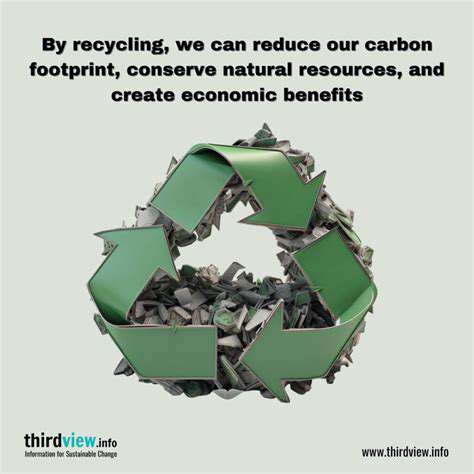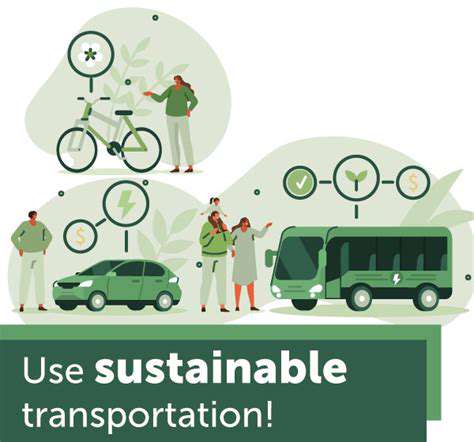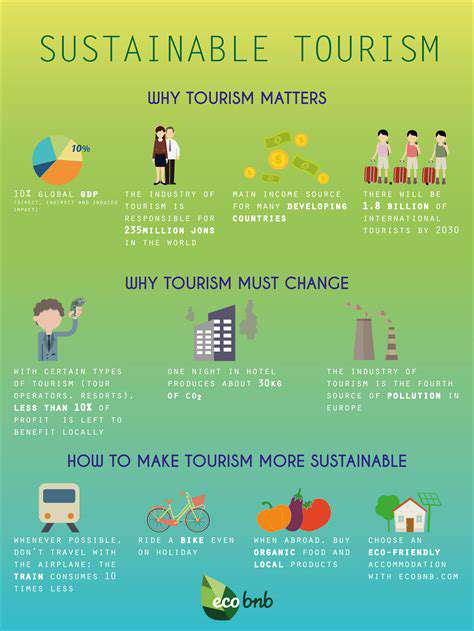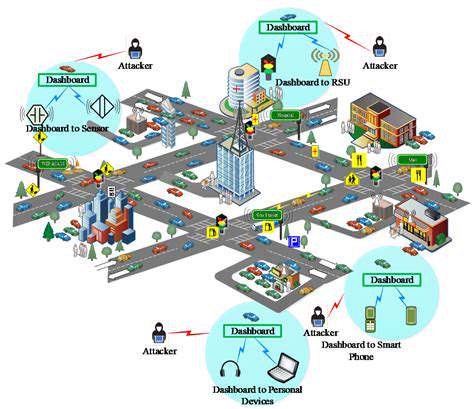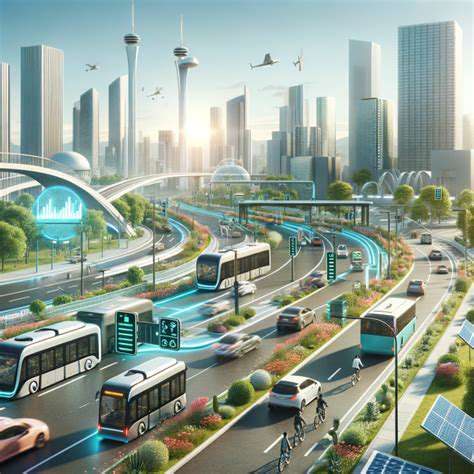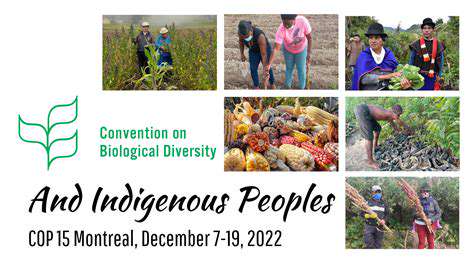Air travel is often the most significant contributor to a trip's carbon footprint. The sheer amount of fuel burned by airplanes results in substantial emissions. However, alternative modes of transportation, like trains, buses, and even cycling or walking, can dramatically reduce your impact. The distance travelled, the type of aircraft used, and the efficiency of the mode of transport all play a crucial role in determining the overall emissions.
Consider the distance and duration of your trip when evaluating different transportation options. A short trip might not warrant a significant shift in your travel choices, but a long-haul flight should certainly be scrutinized for alternatives, such as train travel, which can frequently prove more eco-friendly.
Accommodation Choices and their Impact
The environmental footprint of your accommodation extends beyond just the energy used to power the building. Choosing eco-friendly hotels or resorts that prioritize sustainable practices, such as using renewable energy sources, conserving water, and minimizing waste, is crucial. Looking into hotels with certifications for sustainable practices, like LEED, can provide valuable insight into their environmental commitment. This can include evaluating the local community impact of the accommodation and considering the overall sustainability of the building's design and operational practices.
Food and Consumption Habits During Travel
Food choices and consumption habits during your travels significantly influence your carbon footprint. The transportation of food, packaging materials, and the production methods involved in sourcing the food all contribute to emissions. Opting for locally sourced, seasonal produce whenever possible minimizes the distance food has to travel and reduces the associated emissions. Eating less meat and dairy products, which often have a higher carbon footprint compared to plant-based options, can also make a difference.
Activities and Experiences: Minimizing Your Impact
Beyond transportation and accommodation, your activities and experiences can influence your environmental impact. Choosing eco-friendly tours and activities, supporting local businesses, and reducing your overall consumption of goods and services can all contribute to minimizing your footprint. Instead of taking a private boat tour, consider a guided walk through a local park. This kind of local experience often leaves a far smaller carbon footprint and offers an opportunity for cultural immersion. By choosing experiences that support local economies and minimize waste, you can significantly reduce your carbon footprint.
Offsetting Your Footprint: A Necessary Step?
Even with the most conscientious choices, some carbon emissions are unavoidable. Carbon offsetting programs can help compensate for the unavoidable impact. These programs invest in projects that reduce emissions elsewhere, such as reforestation or renewable energy initiatives. However, it's important to be discerning about the credibility and effectiveness of these programs. Thorough research and due diligence are crucial to ensure that your offsetting efforts are truly making a positive impact. Choosing reputable and transparent programs is essential to ensure that your contributions are effective and genuinely support environmental sustainability.
Choosing Eco-Friendly Transportation Options
Walking and Cycling: The Simplest, Most Sustainable Options
Choosing to walk or cycle instead of driving significantly reduces your carbon footprint. Walking, in particular, eliminates all emissions from transportation, and cycling, while still producing some emissions, is far less harmful than driving a car or using public transport in many situations. These methods also offer numerous health benefits, improving cardiovascular health, promoting physical fitness, and reducing stress. Small changes like walking to the store or cycling to work can add up to substantial environmental impact over time.
Furthermore, walking and cycling promote a deeper connection with your surroundings. You experience the city or neighborhood on a more intimate level, noticing details you might otherwise miss while in a car. This engagement with your environment can also foster a greater appreciation for its beauty and inspire a stronger commitment to its preservation.
Public Transportation: A Collective Effort
Utilizing public transportation, such as buses, trains, or subways, is often a more sustainable alternative to individual car travel. By sharing the transportation resources, the emissions per person are reduced. Depending on the specific system and route, public transport can be more environmentally friendly than driving, especially in urban areas with high population density. It's important to research the specific carbon footprint of your local public transport system to fully understand its impact.
However, the effectiveness of public transportation depends heavily on factors such as the efficiency of the system, the frequency of service, and the availability of routes. A poorly designed or underfunded public transport system might not be as environmentally beneficial as initially anticipated.
Electric Vehicles: A Step Towards Sustainability
Electric vehicles (EVs) are becoming increasingly popular as a sustainable transportation option. They produce zero tailpipe emissions, significantly reducing their impact on air quality and the environment. However, the full environmental impact of EVs also needs to consider the energy source used to charge them. If the electricity comes from renewable sources, like solar or wind power, EVs can be a very sustainable choice.
The production and disposal of the batteries in EVs also contribute to the overall environmental footprint. The responsible sourcing of materials and the development of effective recycling programs are crucial for minimizing the environmental impact of this technology.
Sustainable Aviation Practices: Reducing the Impact of Air Travel
Air travel, unfortunately, has a substantial carbon footprint. However, there are ways to mitigate the impact of air travel. Choosing direct flights, limiting the number of layovers, and flying during off-peak hours can all reduce the overall distance flown and therefore the emissions generated. Furthermore, supporting airlines committed to sustainable practices and technologies, such as using biofuels, can help lessen the environmental impact of your flight.
Offsetting your carbon emissions from air travel is another important consideration. Several organizations provide programs that allow you to compensate for the emissions of your flight by supporting projects that reduce greenhouse gas emissions elsewhere.
Choosing Eco-Friendly Ride-Sharing Services
Ride-sharing services can be a more sustainable alternative to individual car travel, especially in urban areas. By sharing rides, fewer cars are on the road, leading to a reduction in traffic congestion and emissions. Many ride-sharing services prioritize efficiency, reducing the overall environmental footprint compared to multiple individual car trips. However, the environmental impact also depends on factors like the vehicle type used and the overall efficiency of the ride-sharing platform.
Considering Sustainable Travel Alternatives
Beyond the previously mentioned options, exploring alternative travel methods like train travel, ferries, or even carpooling can further minimize your environmental impact. Each mode of transport has its own unique set of environmental benefits and drawbacks. Thorough research and careful consideration of factors such as distance, time constraints, and local infrastructure can help you make informed choices that align with your sustainability goals.
Ultimately, making conscious decisions about your transportation choices can significantly reduce your carbon footprint and contribute to a more sustainable future.
Sustainable Accommodation Practices

Minimizing Environmental Impact
Sustainable accommodation practices prioritize minimizing the environmental footprint of hotels, resorts, and other lodging establishments. This involves adopting energy-efficient technologies, reducing water consumption, and implementing waste reduction strategies. These practices not only benefit the environment but also contribute to long-term cost savings for the business. Sustainable practices often incorporate renewable energy sources, such as solar panels, to power the property and reduce reliance on fossil fuels.
Careful consideration of materials used in construction and renovation is crucial. Using locally sourced, recycled, or sustainable materials reduces the transportation impacts and reliance on virgin resources. This approach is essential for minimizing carbon emissions and supporting responsible sourcing.
Promoting Local Communities
Sustainable accommodation practices often involve supporting local communities. This can include employing local staff, purchasing products and services from local businesses, and partnering with community organizations for charitable initiatives. By supporting local businesses, sustainable accommodations help to stimulate the local economy and create jobs. This also fosters a deeper connection with the area's unique culture and history.
Improving Guest Experiences
Sustainable practices can enhance the guest experience, offering unique insights into the local environment and culture. These accommodations often provide opportunities for guests to engage in eco-tourism activities, learn about local conservation efforts, and support local businesses. Guests are often drawn to properties that prioritize environmental responsibility and social consciousness.
Many sustainable accommodations offer educational programs or tours that highlight local ecosystems and conservation initiatives. This can lead to a more enriching and memorable stay for guests, fostering a deeper appreciation for the natural world.
Resource Management
Efficient resource management is a key component of sustainable accommodation practices. This includes implementing water-saving fixtures, promoting energy-efficient appliances, and minimizing waste through proper recycling and composting programs. Careful tracking and analysis of resource usage are crucial for identifying areas for improvement and achieving significant reductions in environmental impact. Water conservation measures, such as low-flow showerheads and efficient irrigation systems, can significantly reduce water consumption.
Ethical Labor Practices
Ethical labor practices are essential for sustainable accommodations. This includes fair wages, safe working conditions, and opportunities for professional development for all employees. Promoting fair labor practices ensures that the pursuit of sustainability extends to all stakeholders, including the workers who contribute to the operation of the accommodation. This approach fosters a positive work environment and promotes social equity within the community.
Base models are a powerful foundation, but true innovation lies in leveraging their capabilities beyond the initial design. This involves fine-tuning, adapting, and extending these models to perform tasks that go beyond the basic functionalities.
Sustainable Activities and Consumption Habits
Reducing Your Carbon Footprint While Traveling
Traveling can be a wonderful experience, but it often comes with a significant carbon footprint. From the emissions of airplanes and trains to the energy consumption of hotels and the transportation within a destination, the environmental impact can be substantial. Understanding this impact is the first step toward responsible travel. By making conscious choices, travelers can significantly lessen their contribution to greenhouse gas emissions and support a more sustainable future.
Choosing eco-friendly transportation options, like trains or buses, whenever possible is a great way to reduce your carbon footprint. Even opting for carpooling or cycling within a destination can make a difference. Consider the environmental impact of the accommodation you choose, looking for hotels with sustainable practices and energy-efficient features.
Offsetting Emissions
Carbon offsetting is a method of balancing out the emissions you create by investing in projects that reduce emissions elsewhere. These projects often involve renewable energy initiatives, reforestation efforts, or energy efficiency improvements. While offsetting isn't a complete solution, it can help compensate for the unavoidable emissions associated with travel.
Research reputable carbon offsetting programs before choosing one. Ensure the projects align with your values and have measurable results. Remember, offsetting should complement, not replace, other sustainable practices.
Sustainable Transportation Choices
Air travel is typically the most carbon-intensive mode of transportation. Whenever feasible, consider alternative options like trains, buses, or even carpooling. These methods often have a significantly lower carbon footprint per passenger, contributing to a greener journey.
Within a destination, explore the option of cycling or walking. This not only reduces your carbon emissions but also enhances your experience by allowing you to immerse yourself in the local environment and discover hidden gems.
Eco-Friendly Accommodation
The choice of accommodation plays a vital role in your travel's environmental impact. Opt for hotels or guesthouses with established sustainable practices, such as energy-efficient appliances, water conservation measures, and waste reduction programs. Look for certifications that confirm these efforts, ensuring you're supporting responsible businesses.
Conscious Consumption During Travel
Beyond transportation and accommodation, your consumption habits during your trip also matter. Reduce your reliance on single-use plastics by carrying a reusable water bottle, coffee cup, and shopping bag. Support local businesses and artisans, reducing the transportation impact of imported goods.
Minimizing Waste and Recycling
Practicing waste reduction and proper recycling is crucial, especially in hotels or vacation rentals. Dispose of trash responsibly, separate recyclable materials, and avoid generating excessive waste in the first place. Bring reusable containers for food and snacks to minimize packaging waste.
Supporting Sustainable Tourism Initiatives
Choose tour operators and businesses that prioritize sustainability. Look for companies committed to preserving the environment and supporting local communities. Participating in eco-tours or supporting conservation efforts can amplify your positive impact.
By actively considering these factors and making informed choices, travelers can significantly reduce their carbon footprint and contribute to a more sustainable future for the planet.
Offsetting Your Emissions and Supporting Sustainable Tourism
Understanding Your Carbon Footprint in Tourism
The travel and tourism industry, while a vital economic driver, often carries a significant carbon footprint. From the emissions generated during air travel and accommodation to the transportation required for excursions and the energy consumption of tourist attractions, the overall impact can be substantial. Understanding the different sources of emissions associated with your travel choices is the first step towards mitigating your environmental impact and supporting more sustainable tourism practices. This involves recognizing the various stages of a trip, from booking flights to visiting local businesses, and evaluating the environmental consequences of each.
Quantifying your personal carbon footprint in tourism requires careful consideration of factors like flight distance, accommodation type (e.g., hotels versus eco-lodges), and the activities you engage in during your trip. Tools and resources are available online to help estimate the emissions associated with specific travel plans, providing actionable insights into areas for improvement. By recognizing the environmental impact of our choices, we can become more conscious travelers and work towards a more sustainable approach to tourism.
Offsetting Emissions: A Practical Approach
Offsetting your carbon emissions is a crucial step in reducing the environmental impact of your travel choices. This involves investing in projects that reduce or remove greenhouse gases from the atmosphere, effectively compensating for the emissions generated during your trip. These projects often focus on renewable energy development, reforestation efforts, or other initiatives that promote sustainability. Choosing reputable offsetting programs that align with your values is important, ensuring the funds are used effectively and transparently.
Many travel companies and booking platforms now offer carbon offsetting options. Understanding the specific projects supported and the methodology behind the offsetting process is key to making informed decisions. By proactively supporting these initiatives, you contribute to a broader effort to mitigate the effects of climate change and foster more sustainable tourism practices. Choosing to offset your emissions is a tangible way to lessen your personal impact on the environment.
Promoting Sustainable Tourism Practices
Beyond offsetting, supporting sustainable tourism practices directly benefits both the environment and local communities. This involves opting for eco-friendly accommodations, utilizing public transport or cycling whenever possible, and choosing tour operators and businesses committed to environmentally responsible practices. Supporting local businesses and artisans directly contributes to the economic well-being of the communities you visit, fostering a more equitable and sustainable tourism ecosystem. By selecting accommodations with a focus on energy efficiency, water conservation, and waste reduction, you can play a direct role in maintaining the natural beauty and resources of the destinations you explore.
Choosing to eat locally sourced food, reduce your waste, and participate in eco-tours that prioritize conservation efforts are all ways to actively promote sustainable tourism. Your choices as a traveler have the power to create a ripple effect, influencing the practices of businesses and the overall sustainability of the destinations you visit. By encouraging sustainable practices, we contribute to a future where tourism benefits both people and the planet.


